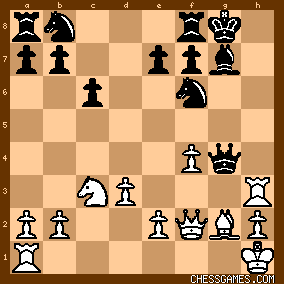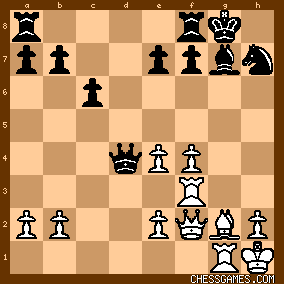| Sep-29-08 | | whiteshark: With the wisdom of hindsight: Thou should not play 11...g5 against Tal. A sort of exhibitionistic attitude. |
|
| Sep-29-08 | | safar: 17...Bxc3 is the blunder. Where is the White win after 17...Qxf5, followed by Nf6 and bNd7? White is a piece down. |
|
| Sep-29-08 | | IT4L1CO: <safar: 17...Bxc3 is the blunder. Where is the White win after 17...Qxf5, followed by Nf6 and bNd7? White is a piece down.> with no deep analysis, maybe 18 e4 Qg6 19 Rg3 Qf6 20 Qh5. Now if Black queen moves 21 Rh3 Nf6 22 Qh4 and e5 to follow... |
|
| Sep-29-08 | | thezimboman: If that 17... Qxf5, then, I think,
18. Rf3 (pinning the bishop) followed by Be4 will just enough for white to stock up on h6. Even if black would try Qh6 on such occasion, white can just reply Rg3-h3 then. |
|
| Sep-29-08 | | whiteshark: <safar: <17...Bxc3 is the blunder.>> Yes, it was. |
|
| Sep-29-08 | | whiteshark: <safar: <Where is the White win after 17...Qxf5, followed by Nf6 and Nbd7? White is a piece down.>> Well, after <17...Qxf5 18.Rh3 Nf6 19.Kh1 Qh7 20.Qg5 Qg6 21.Qh4 Qg4 22.Qf2> 
click for larger view White is still ♘:♙ down, but threats like 23.Rg1 followed by Qh4, a rook doubling in the g-file or a pawn push in the center starting with e4 could offer enough compensation. |
|
| Mar-13-21 | | Gaito: whiteshark: With the wisdom of hindsight: "Thou shall not play 11...g5 against Tal".
I agree, but the strong chess engine LcZero endorses the move 11...g5, and so does Stockfish 13. Both engines consider the position to be roughly equal after 11...g5. |
|
| Mar-13-21 | | Gaito: It seems that the sacrifice 12.Bxg5!? was a typical speculative sacrifice by Tal. Both engines Lc Zero and SF13 consider that White's best move is 12.Qc4.
Speculative sacrifices often worked well for Tal, but not for other players. That is why we can admire, but should not attempt to copy or imitate Tal's style of play. |
|
| Mar-13-21 | | Gaito: Black's first mistake, according to the engine's opinion, happened in the following position:

click for larger view
BLACK TO MOVE
The Bulgarian grandmaster played 14...Nh7?, which is an inferior move according to the computer. The engine suggests that Black play 14...Bg6! with equality.
A possible continuation would have been
14...Bg6 15.Bh3 e6 16.f5!? (16.e4 also deserves some attention, but it leads to an equal game too) 16...exf5 17.e4 Qd8! (also good is 17...Nbd7=) 18.exf5 Bh7 (18...Bh5!? also leads to a successful defense) 19.Nce4 Nbd7 20.Kh1 Re8
(Diagram)

click for larger view
The computer evaluates this positon as equal or unclear. Black has a piece for two pawns, but White has no immediate chance to bring about a succcessful K-side attack. Maybe only in the long run and against a weak defense by Black. The numerical evaluation of this position by the computer is 0.00. |
|
| Mar-14-21 | | Gaito: Dimitar Donchev was awarded the title of grandmaster in 1990, so that he was only an international master when this game was played. His peak rating was 2495, and among his victims we can find illustrious names, such as Topalov or Savon. Donchev was Bulgarian Champion twice: in 1983 and 1988.
In this game Tal displayed his usual skill in the art of attack, but the Bulgarian master was unable to show a decent skill in the art of defense. |
|
| Mar-14-21 | | Gaito: The critical moment of the game occurred after Tal played 17.Rf3:

click for larger view
BLACK TO MOVE
Here Black decided to part with the best defender of his king: 17...Bxc3??, and this blunder proved to be a suicide, especially against someone like Tal. Black could have put up a sturdy resistance with 17...Qxf5! For instance: 18.Ne4 Nd7 19.Kh1 Ndf6 20.Rg1 Nxe4 (20...Qh5 is also worthy of consideration) 21.dxe4 Qf6 22. Qf2 (Qe1 is also possible, but maybe not an improvement) Qd4 (diagram):

click for larger view
WHITE TO MOVE
The verdict of the engine is that "White has a minimal advantage" (numerical evaluation by the computer is +0.29) |
|
| Mar-14-21 | | Gaito: What was curious about Tal's speculative sacrifice 12.Bxg5!? is that no matter if the attack failed, White never was in danger of losing. The worst that could have happened to Tal would have been to draw the game, and that would have occurred only if Black defended very well.
It is common knowledge that most chess players have a good working ability in the art of attack but are comparatively weak when they have to defend an inferior position. That was one of the keys of Tal's tremendous success against ordinary chess masters. But when Tal had to play someone who was really skilled in the art of defense (like Viktor Korchnoi, for example), he often had poor results. The same happened about 100 years ago with Frank J. Marshall: he was a tremendous attacking player with very good results against ordinary chess masters; yet when he had to play against a skilled defensive master (like Lasker or Capablanca), Marshall often fared badly.
Was Mikhail Tal also a good defender? You bet he was, though he normally preferred to attack. But if you want to see Tal as a successful defender of an inferior position, take a look at this game: Fischer vs Tal, 1959 |
|
| Mar-14-21 | | Gaito: I have an old recollection when I was a little boy (about 12 years old), and I was playing a friendly chess game at the YMCA in Mexico City. There were several old men watching the game, and among them there was a chess master. I had the black pieces and in a certain moment of the game I decided to exchange my bishop on g7 for White's knight on c3 (just like in the Tal vs. Donchev game): The master observed: "kid, how dare you exchange the valuable bishop that is protecting your king for a useless knight?". Since that time I have never made such an atrocity. Years later I noticed that Bobby Fischer once exchanged his bishop from g7 for a "useless" white knight on c3. But Fischer was Fischer! If you want to see that game, here is the link: Quinteros vs Fischer, 1970
Fischer played 6...Bxc3. Fischer was a genius, and he could do that and even more bizarre things. If you are a genius you are allowed to do that too. |
|
Sep-17-21
 | | kingscrusher: <Gaito> Are you using the latest Stockfish NN version? it is about +2 for White on Qxf5
Tal's intuition for correctness was very powerful indeed 225: Mikhail Tal - Dimitar I Donchev 1-0 0.0, Yerevan Yerevan URS 1986

click for larger viewAnalysis by Stockfish 14:
1. +- (2.00): 18.Kh1 Kh8 19.Rg3 Qf6 20.Qg4 Qg6 21.Qf3 Qe6 22.Bh3 f5 23.Rag1 Bxc3 24.bxc3 Nd7 25.e4 Nc5 26.Bxf5 Rxf5 27.exf5 Qd5 28.Qxd5 cxd5 29.Re1 Re8 30.Rge3 Rg8 31.Rh3 Rg7 32.Re5 Kg8 33.Rg3 Rxg3 34.hxg3 Nf6 35.Rxe7 Nxd3 36.Rxb7 Black had made a mistake earlier with 14...Nh7 and it seems to be a lost position technically from that point on. Intuitive considerations
1. Light square bishop without a counterpart
2. g file road
3. Black's largely irrelevant pieces for defending king |
|
Sep-17-21
 | | kingscrusher: <Gaito> I have done some of the same analysis as you but maybe a bit more empathetic - you know that on 14.f4 The engine suggestion is Bg6 - but the thing is that seems really quite counter-intuitive: 226: Mikhail Tal - Dimitar I Donchev 1-0 0.0, Yerevan Yerevan URS 1986

click for larger viewAnalysis by Stockfish 14:
1. = (-0.28): 15.Bf3 e6 16.Be4 Nxe4 17.dxe4 f6 18.Nh3 b5 19.g4 Nd7 20.f5 Bh7 21.Kh1 b4 22.Nd1 Qc7 23.g5 exf5 For me in a practical sense especially when playing on faster time controls, one needs to factor in how "easy the position is to play" - and a sacrifice like Bxg5 should be imitated by everyone in my view as it gives great practical chances. As Tartakower has indicated
"The blunders are all there waiting to be made" or to that effect. Not so much if you are playing in ICCF engine assisted correspondence chess though - sure - best to not take any exploitable risks there! |
|





